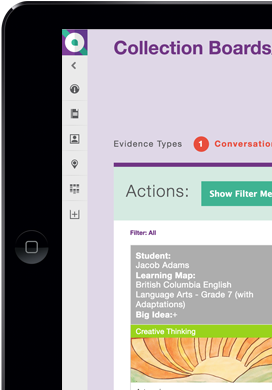ASSESSMENT 101
What is QUIO Learning Map?
THE LEARNING JOURNEY: QUIO Learning Map helps teachers arrive at an accurate assessment of your child’s learning. Evidence of learning is aligned with curricular outcomes illuminating your child’s strengths and challenges. Combined with teacher and student feedback, this allows you to be more involved and aware of your child’s progress.
Is the QUIO Learning Map difficult to use?
EFFECTIVE COMMUNICATION: The QUIO Learning Map uses the ePortfolio and Learning Map to convey student progress for effective communication between parents, teachers, and students. Simply use the login information sent by your child’s teacher to access your child’s learning journey in an easy-to-read format.
My child is in a modified/ESL/IEP program. How will the Learning Map work for them?
ONE SIZE DOES NOT FIT ALL: A flexible framework allows teachers to modify assessment criteria based on the needs of individual students, including those in modified, ESL, or IEP programs.
Is my child’s information safe?
BANK LEVEL DATA PROTECTION: QUIO stores student data in one private, protected location that is monitored for security. Customized, password-protected privacy settings are an integral feature of the software, with different views for teachers, students, and parents. QUIO is compliant with the Freedom of Information and Privacy Acy (FIPPA) and all data is encrypted on secure servers and hosted in Canada.
What does a Learning Map look like?*
EASY-TO-READ FORMAT: One approach is to use a Learning Map which shows:
- The “Big Ideas”: what students are expected to learn and be able to do
- Descriptions of learning
- Specific evidence of learning, which is evaluated by a teacher to determine a letter grade (such as tests, presentations, projects, and teacher observations)
- Highlighted sections of the Learning Map that show how your son/daughter is performing in relation to grade level expectations for each of the “Big Ideas”
The QUIO Learning Map is adaptable to a variety of teaching methods and approaches, so your child’s Learning Map may look a bit different.
What are the benefits of using a Learning Map?*
REMOVE THE MYSTERY OF LETTER GRADES: A Learning Map demonstrates the learning behind the letter grade symbol. When the components of the letter grade are mutually understood by teachers, students and parents, then conversations can become more about the learning and less about numbers, percentages, or grades.
Questions such as “What needs to happen to get a better grade?” “She did well on her tests – why did she get a C?” or “What does it take to get an A in this class?” are all answered by looking at the Learning Map. This can help students take more responsibility for their learning because they see the steps they need to take to improve.
Still have questions? Take a look at our Assessment FAQ page.
*These answers are modified from Appendix 4: Parent Brochure from Rethinking Letter Grades: A Five-Step Approach for Aligning Letter Grades to Learning Standards by Caren Cameron and Kathleen Gregory


